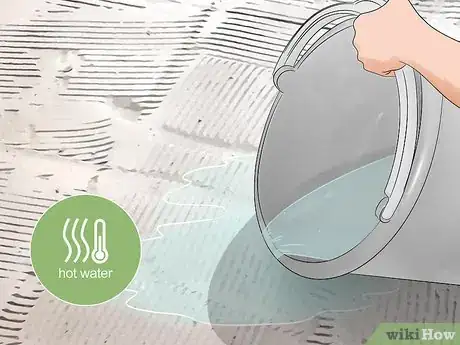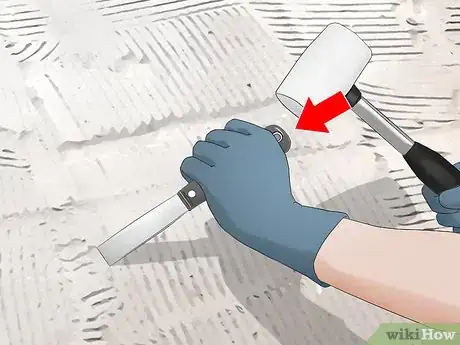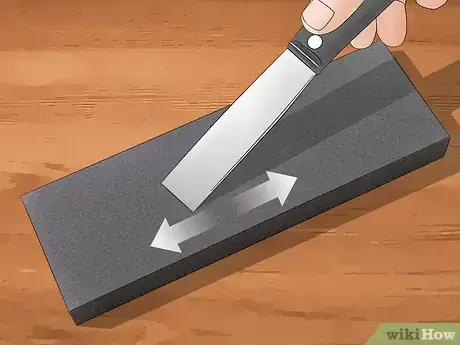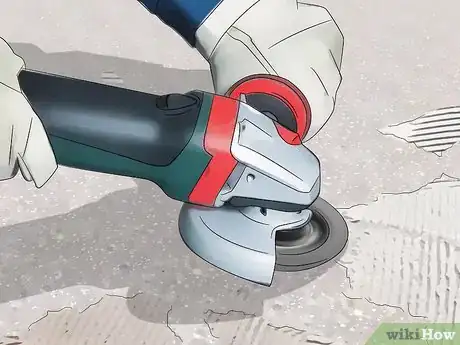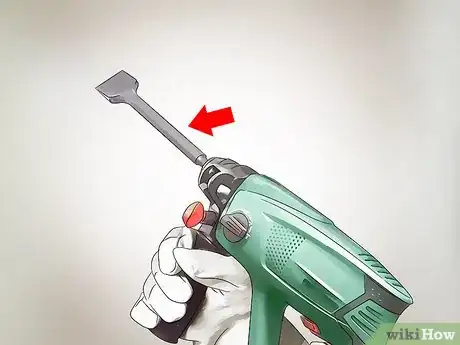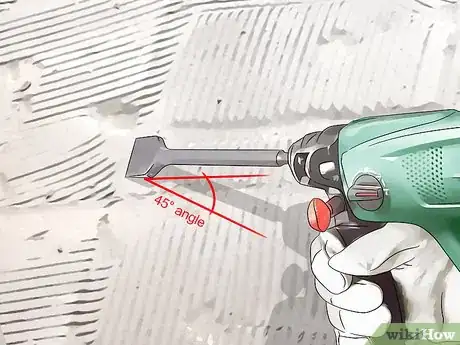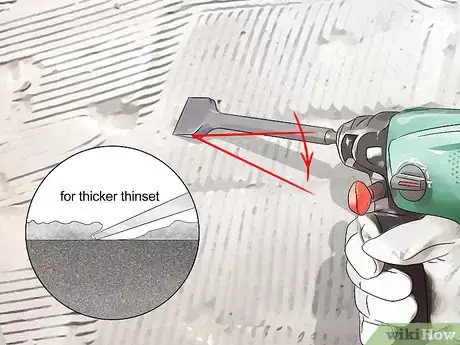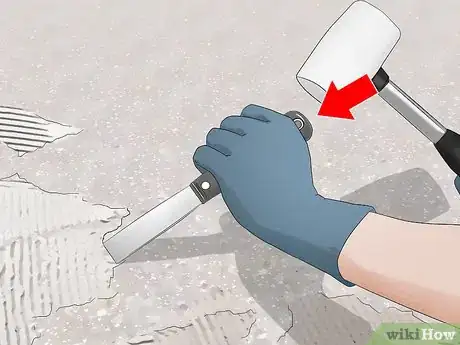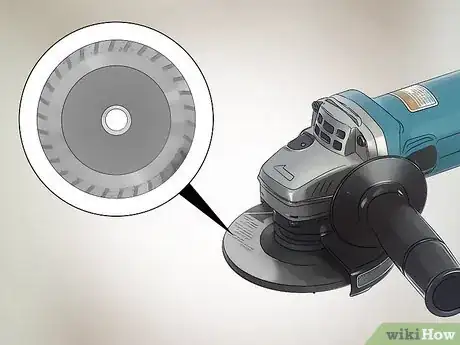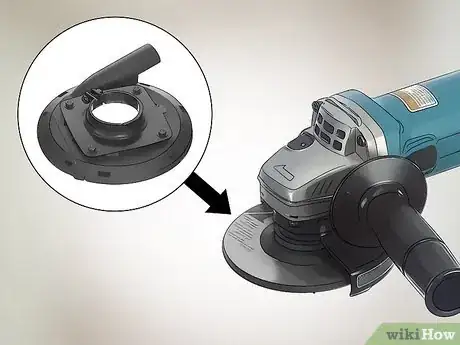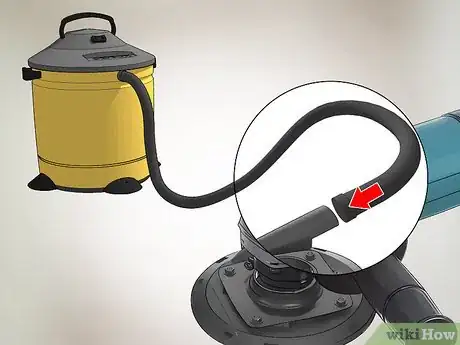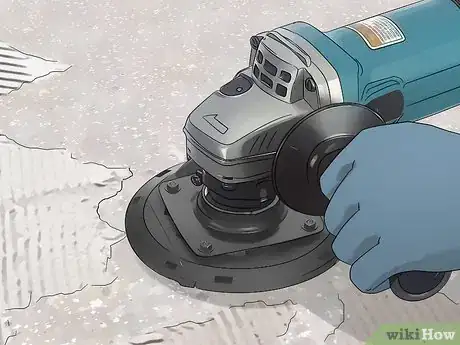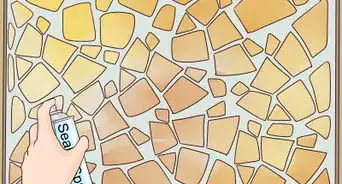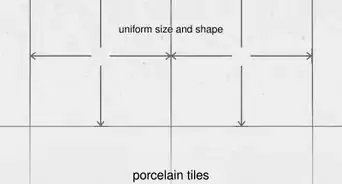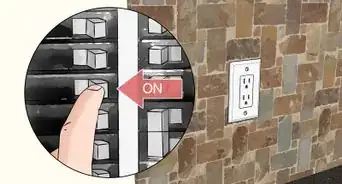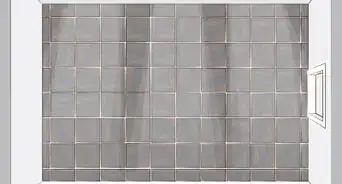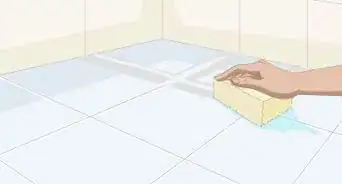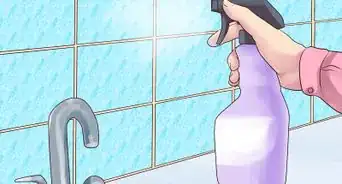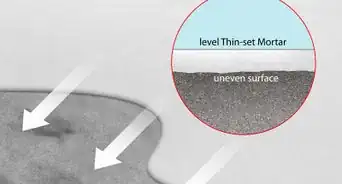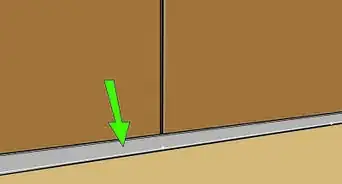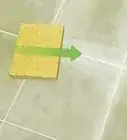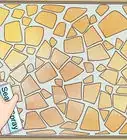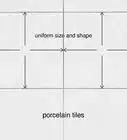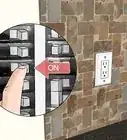This article was co-authored by Sam Adams. Sam Adams is the owner of Cherry Design + Build, a residential design and construction firm, which has been operating in the Greater Seattle Area for over 13 years. A former architect, Sam is now a full-service contractor, specializing in residential remodels and additions.
There are 9 references cited in this article, which can be found at the bottom of the page.
This article has been viewed 169,502 times.
There are a few main ways to safely remove thinset without damaging any surfaces, and the best method for you to use will depend on what type of surface you used the thinset on. Delicate surfaces, like kitchen walls and wood floors, will require using an angle grinder to gently scrape away the thinset. More sturdy surfaces, like concrete or other tough materials, can be treated with stronger methods, either using a hammer drill or a putty knife. In any case, you should plan to be very careful so as to not risk ruining your home or injuring yourself in the process!
Steps
Chipping Thinset Away with a Putty Knife
-
1Pour 0.39 gallons (1.5 L) of boiling water gently over the thinset. Within 40 to 60 minutes of water application, you should notice cracks starting to appear in your thinset. This decreases its integrity and makes it much easier to remove using a putty knife.[1]
- Purchase 0.39 gallon (1.5 L) cooking pots from home hardware stores.
- Pots that are 0.39 gallons (1.5 L) in size will cover a region of approximately 107.639 square feet (10.0000 m2).
- Add 1 cup (240 ml) of citrus degreaser or vinegar to your pot to help weaken the thinset.
-
2Hammer your 1 in (2.5 cm) putty knife at a 45-degree angle to the thinset. Firmly hit the end of the knife with the flat end of a 2 lb (0.91 kg) hand maul. Don't hit the knife too hard or you risk breaking the blade and damaging your flooring. After 20 to 30 seconds of hammering, you should notice the thinset breaking apart. If not, pour some more boiling water over it to loosen it.[2]
- You can also use a masonry chisel that is the same width.
- Continue removing the thinset in small chunks until you've removed enough to accommodate your new tiles.
- Always use a putty knife with a hammer-end handle and sharp blade.
Advertisement -
3Sharpen your putty knife when it gets dull. Hold the knife at a 20-degree angle to a sharpening stone on the left or right side. Align it perpendicular to the stone, and then drag it down its length. Flip the knife over and repeat this motion with the motion side of the blade. Continue this process until your knife is sharp enough to consistently remove thinset.
- Use a coarse stone for sharpening first. If your knife still needs sharpening afterward, use a fine stone.[3]
- Apply 1 drop of sharpening or honing oil to the surface of the stone and rub it in with your finger prior to sharpening. These products can be purchased at home hardware stores.
- Between the 2 stones, the grit range should be 325 (coarse) to 1200 (extra fine).
-
4Remove the remaining thinset with an angle grinder. Attach a 5 to 7 in (13 to 18 cm) diamond cut wheel to an angle grinder with a 4.5 in (11 cm) cup wheel. Connect a 5-horsepower wet-dry vacuum to the grinder by pressing its hose into the hole located in the dust shroud. Move the grinder in up and down motions, working in sections about 2 to 3 ft (0.61 to 0.91 m) long at a time.[4]
- You can typically remove enough thinset with a chisel to lay tile evenly, but it's very difficult to completely remove all of it. For the smoothest possible surface, finish the job with an angle grinder and a diamond grinding wheel.
Using a Hammer Drill
-
1Attach a 2 to 3 in (5.1 to 7.6 cm) chisel bit to your hammer drill. Most bits slide into the front of the gun. To remove them, pull back on the collar around the bit nozzle and slide them out. Be sure to turn the gun's rotation off before using your chisel bit.[5]
- Stick to wider chisels—they work better for removing thinset and help your work progress much faster.
- Refer to the instructions for your hammer drill—some have different routines for swapping bits and locking rotation.
-
2Place the blade at a 45-degree angle to the thinset surface. Grip the front handle with your non-dominant hand and the back handle with your dominant hand. Pull the trigger and run the chisel along the thinset in straight vertical motions about 1 to 2 ft (0.30 to 0.61 m) in length at a time.[6]
- Set your drill to the hammer setting.
- Avoid applying pressure to the ground unless you encounter stubborn areas.
- You can rent hammer drills from most home hardware shops.
-
3Decrease the angle of your chisel blade for thicker thinset. Some guns allow you to the lock the bit at a specific angle. Make sure the rotation is off and turn the selector to the "0" setting. Decrease the angle of the chisel, and then turn the selector back to the hammer setting to lock the angle in place. For extremely stubborn areas of thinset, apply a bit of pressure as you move the tool.
- Avoid increasing the angle above 45 degrees—this can damage the blade.
-
4Remove smaller patches of thinset using a chisel. Place a 1 inch (2.5 cm) putty knife at a 45-degree angle to the remaining thinset patches. Use the flat end of a 2-pound (0.91 kg) hand maul to hit the end firmly. You should notice the thinset patches breaking apart after about 20 to 30 seconds of hammering.
- Continue using your hammer and chisel to remove the remaining patches of thinset.
- Removing thinset with a hammer drill is prone to leaving small patches along your floor. If you're having trouble with patches, use a hammer and chisel or grinder to get rid of them.
Removing Thinset with an Angle Grinder
-
1Attach a 5 to 7 in (13 to 18 cm) diamond cut wheel to your grinder. If your tool comes with a wheel outside of this size range, you need to swap it out. Remove the plate on top of the wheel by turning it counterclockwise with a wrench. Take out the second plate, also known as the cup wheel, and your blade should be easily removed. Swap in your new diamond wheel, put the cup wheel back on, and then screw the top plate back into place.[7]
- A 4.5 in (11 cm) cup wheel is best for this job. If you notice your grinder has a smaller one, swap it out with one that is the proper size.
-
2Replace your dust shroud if necessary. If your dust shroud is loose when you move it, consider installing a new one. After removing your blade and before attaching a new one, flick the dust shroud's latch and pull it outward from the grinder. Swap out the circular plastic spacer with a new one.[8]
- Sand your spacer with rough 40- to 60-grit sandpaper to decrease its size. Rub the sandpaper along the outside of the spacer in a circular motion. It shouldn't take more than 5 minutes to reduce its size with rough sandpaper.
- After sanding, your dust shroud should fit snugly onto the spacer without jiggling.
-
3Connect the grinder to a 5-horsepower wet-dry vacuum. The vacuum hose connects at the top of the grinder to the dust shroud. Press it into the hole in the dust shroud and it should pop in easily. After attaching it, secure the perimeter of the hose's seal with at least 1 layer of duct tape to prevent particle leakage.[9]
- Always turn on your vacuum before you turn on the grinder.
-
4Guide the 7 in (18 cm) grinder along the thinset. Turn on your grinder and grip the front handle with your non-dominant hand and the back handle with your dominant hand. Use your back hand to push the grinder forward and pull it backwards. Hold the grinder steady with your top hand to keep it from moving around.[10]
- Move the grinder up and down in motions and aim to cover about 2 to 3 ft (0.61 to 0.91 m) of vertical space with each motion. Slowly move it to the right or left as you grind and don't worry about going over the same spot more than once.
Expert Q&A
-
QuestionHow do you prepare the subfloor for tile?
 Sam AdamsSam Adams is the owner of Cherry Design + Build, a residential design and construction firm, which has been operating in the Greater Seattle Area for over 13 years. A former architect, Sam is now a full-service contractor, specializing in residential remodels and additions.
Sam AdamsSam Adams is the owner of Cherry Design + Build, a residential design and construction firm, which has been operating in the Greater Seattle Area for over 13 years. A former architect, Sam is now a full-service contractor, specializing in residential remodels and additions.
Professional Contractor If you want to lay down tile after removing thinset, make sure you create a smooth surface. When you install tile, the most important things are that the walls are square and the surface is flat and level. Old thinset makes the surface uneven, so if you plan to install new tile, make sure you grind all the thinset off.
If you want to lay down tile after removing thinset, make sure you create a smooth surface. When you install tile, the most important things are that the walls are square and the surface is flat and level. Old thinset makes the surface uneven, so if you plan to install new tile, make sure you grind all the thinset off.
Things You'll Need
Chipping Thinset Away with a Putty Knife
- 0.39 gallon (1.5 L) cooking pot
- 1 in (2.5 cm) putty knife
- 2 lb (0.91 kg) hand maul
- 2 sharpening stones (1 coarse and 1 fine)
Using a Hammer Drill
- Rotary hammer drill
- 2 to 3 in (5.1 to 7.6 cm) chisel
Removing Thinset with an Angle Grinder
- Angle grinder
- 5 to 7 in (13 to 18 cm) diamond cut wheel
- 5-horsepower wet dry vacuum
- Dust shroud
- Plastic spacer
- 40- to 60-grit sandpaper
- Duct tape
Warnings
- Always wear an N95 respirator and protective eye gear. Removing thinset releases silica through dust, when can damage your lungs and eyes.⧼thumbs_response⧽
- Wear a hat to prevent thinset from getting in your hair—it's difficult to wash out.⧼thumbs_response⧽
- Cover nearby items with plastic when using a grinder.⧼thumbs_response⧽
- Work in 15-minute intervals to prevent your equipment from overheating.⧼thumbs_response⧽
- Always have thinset tested by asbestos experts if you're working in an older home. This is necessary to protect your health.⧼thumbs_response⧽
References
- ↑ https://www.greenhousecenter.net/how-to-remove-thinset/
- ↑ https://www.familyhandyman.com/tiling/remove-ceramic-tile-from-a-concrete-floor/view-all
- ↑ https://www.cooksillustrated.com/articles/218-how-to-sharpen-kitchen-knives#whetstone
- ↑ https://youtu.be/8yFJag8x6gk?t=6m59s
- ↑ https://youtu.be/M75IIi0i4x0?t=3m46s
- ↑ https://youtu.be/hqoETYtMHQc?t=1m34s
- ↑ https://youtu.be/8yFJag8x6gk?t=6m59s
- ↑ https://youtu.be/8yFJag8x6gk?t=8m20s
- ↑ https://youtu.be/SNCBTqiqU6I?t=1m56s
About This Article
To remove thinset, start by pouring boiling water over the thinset to weaken the material. Leave it for an hour, then hold a sharp putty knife at a 45-degree angle and hammer the back with a hand maul to break up the thinset. If you're unable to remove all of it, smooth out the surface with an angle grinder and a diamond grinding wheel. Alternatively, attach a chisel bit to a hammer drill and hold it at a 45-degree angle. Then, chisel it away in straight motions of 1-2 feet in length at a time. If the thinset is especially thick, decrease the angle of your chisel blade to make it easier. Finish any small patches off with a hand-held chisel and hand maul. For more tips from our Construction co-author, including how to remove thinset using an angle grinder and wet-dry vacuum, read on!
